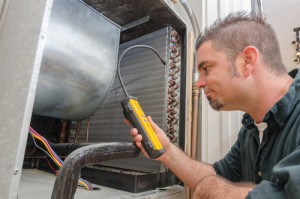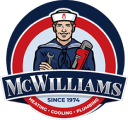
Main Parts of an A/C System and How They Interact
The main parts of a cooling system include the thermostat, the compressor, the evaporator and condenser coils, the air handler, and the ductwork. When the air temperature inside your house goes above the thermostat’s A/C setting, a signal is sent to turn the air conditioner on. The coils transfer heat to and from a refrigerant that circulates in a loop between the outdoor A/C unit and the parts of the system inside your house. The air handler blows cold air into the ductwork, which distributes it throughout your home. When the air temperature at the thermostat falls to the set temperature, the thermostat sends a signal to shut the system down.
Evaporator and Condenser Coils
When the system’s refrigerant changes from a liquid to a gas, it absorbs a great deal of heat energy. When it changes back to a liquid, it gives up the heat it absorbed. A/C coils are heat exchangers that transfer heat to and from the refrigerant running in the loop between the outdoor A/C condenser and the cooling equipment inside your house.
Your house cools off when the refrigerant carries heat from inside the house and releases it outside. It accomplishes this by turning to a gas inside the evaporator coil, which is located near the air handler inside the ductwork, and changing back to a liquid in the condenser coil, which is located in the outdoor A/C unit.
As the refrigerant expands, it absorbs heat from the air via the thin metal fins that are attached to the tubing inside the evaporator coil. The resulting cold air surrounding the coil is blown throughout your house via the ductwork. The evaporated refrigerant then moves to the condenser coil in the outdoor unit, where it gives up its heat via the thin metal fins in the coil. The refrigerant is then returned as a liquid to the indoor unit to repeat the cycle until the thermostat shuts the system down.
If you have a heat pump, the system works just like an air conditioner, except the system can be reversed to provide indoor heat on cold days, with the coil indoors serving as the condenser coil and the coil in the outdoor unit serving as the evaporator coil.
Why Routine Maintenance Matters
It’s important to perform routine maintenance to keep your air conditioner running efficiently. Cleaning the evaporator and condenser coils is an important step in your HVAC technician’s annual maintenance service. Dirty coils inhibit heat transfer and can significantly reduce your air conditioner’s energy efficiency.
You can also take steps to keep your A/C system clean so the coils stay clean and efficient. Changing the air filter regularly keeps dust, pet hair, and other debris out of the air handler’s moving parts and away from the evaporator coil. Keeping grass clippings and weeds away from the outdoor unit allows free airflow and keeps the condenser coil clean for efficient heat transfer out of your house.
Reach out to our team at McWilliams Heating, Cooling, & Plumbing to learn more about our A/C services. With us by your side, you can rest assured that we will take care of your cooling system’s evaporator and condenser coils. Contact us today to schedule an appointment for your Lufkin or Nacogdoches home.
Image Provided by Shutterstock.com


